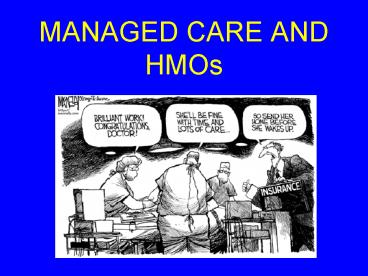MANAGED CARE AND HMOs - PowerPoint PPT Presentation
1 / 19
Title:
MANAGED CARE AND HMOs
Description:
MANAGED CARE AND HMOs. Management of Health Care ... HMOs ... these make HMOs attractive both to those who expect little health care needs and ... – PowerPoint PPT presentation
Number of Views:26
Avg rating:3.0/5.0
Title: MANAGED CARE AND HMOs
1
MANAGED CARE AND HMOs
2
Management of Health Care
- If traditional fee-for-service creates incentives
for overprovision, is it possible to manage
health care delivery so as to overcome this
effect? - Do some forms of managed care generate incentives
for underprovision?
3
What is Managed Care?
- Provision of care to defined enrollees at a fixed
(capitated) rate - Means all levels of care (outpatient, inpatient,
hospital services, labs, etc.) must be integrated
under a fixed budget (vertical integration) - Under FFS, more volume means more profit under
managed care, more volume means less profit
4
HMOs
- Organization that provides enrollees with
comprehensive care in exchange for a prepaid
premium - Staff model HMO hires salaried staff physicians
- Group model HMO is primarily an insurance
provider which contracts with physician group to
provide the care
5
Incentives
- HMO incurs the cost of treatment
- Thus, incentive to reduce cost of each treatment
and to reduce treatments - Also incentive to avoid need to treat
- preventive care
6
PPOs
- Consumer given financial incentives to receive
health care from selected panel of providers - Providers chosen on basis of low cost practice
styles - Can PPOs successfully choose providers with
efficient practice styles?
7
Development of HMOs
- Slow, until recently
- Organized medicine resisted
- resisted loss of physician control
- HMOs prevent price discrimination
8
Price Discrimination
- If a monopolist can separate customers into
groups that have different demands, then price
discrimination is possible - Different prices for different customers
- Price discrimination increases the monopolys
profits - Only possible if the good or service cannot be
resold
9
Price Discrimination Illustrated
Area A Profit w/o price discrimination Area
(ABC) Profit w/ discrimination
B
A
C
MCAC
DMR (w/ discrimination)
Output
Qno disc
Qdisc
0
MR (w/o discrimination)
10
The Pros and Cons of HMOs
- The pros
- typically provide comprehensive coverage
- typically include preventive care
- little or no copayment or deductible
- waiting time short w/ appointment
- these make HMOs attractive both to those who
expect little health care needs and those who
expect a lot
11
- The cons
- limited choice of providers
- access to hospitals is limited
- travel time to provider and hospital may be
longer - access to specialist only through gatekeeper
- ability to maintain long-term relationship with
provider difficult - HMOs unattractive to those who value long-term
relationships and choice
12
HMO Cost Advantages
- May reduce quantity and intensity of treatment
- no incentive to provide unnecessary care or
diagnostic procedures - May substitute lower-cost care for higher-cost
care - no insurance induced bias toward inpatient care
- incentive to use generics
13
- May have scale economies and bulk purchasing
advantages - May be quicker to employ effective utilization
review - HMOs have clear incentive to monitor providers,
FFSs dont - No incentive to over-capitalize
- May be more likely to use effective preventive
care - May be better able to spread fixed administrative
costs
14
Are HMO Costs Lower?
- Empirical studies support expectation that HMOs
use less costly services and offer more
comprehensive coverage
15
The Problem of Selection Bias
- Is the lower cost due to the characteristics of
HMOs or to selection bias? - do HMOs attract healthier patients?
- case study by Strumwasser et al. (1989) found
that employees of a firm who switched to HMO were
younger, had much lower utilization rates, and
had incurred much lower costs in the previous
year - Regression techniques
- control for patient characteristics
16
The Rand Experimental Study
- Random assignment to an HMO and to FFS plans with
various copayments - Also compared to a control group of previously
enrolled HMO customers - HMO groups had considerably lower costs due to
- lower rate of inpatient admissions
- shorter inpatient stays
- Ambulatory care about the same
- Somewhat more preventive care by HMO
17
Quality of Care
- Do HMOs reduce costs by cutting corners with
quality of care? - Limits to reducing quality
- may increase costs down the road
- reputation damage
- the importance of competition
18
Empirical Results
- Studies by Luft (1981) and Miller and Luft (1994,
1997) indicate - HMO patients receive more preventive care
- outcomes at least as good as FFS, if not better
- patient survey shows
- greater satisfaction with cost to patient
- less satisfaction with quality of care
- less satisfaction with patient-doctor
interactions
19
Growth In Costs
- Does the growth in costs differ?
- Studies indicate that the growth in health care
costs about same in FFS and HMO settings - Thus, cost advantage of HMOs not eroding over
time but the problem of the growth in costs at a
faster rate than in other sectors still evident































